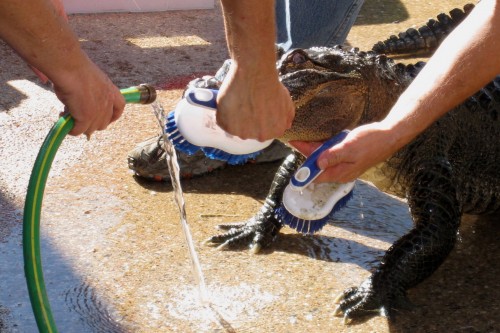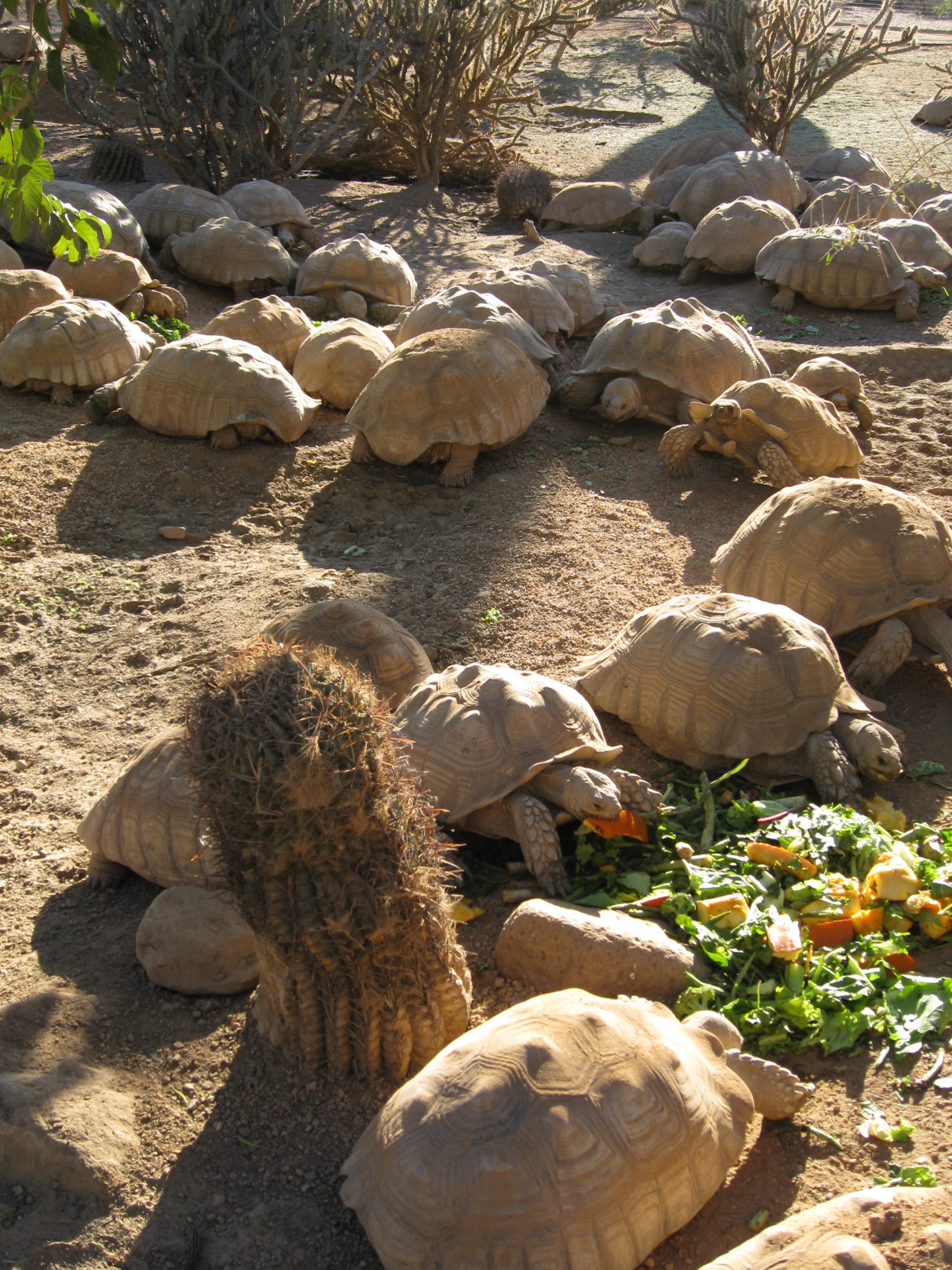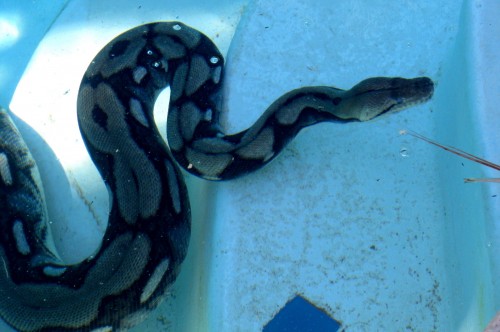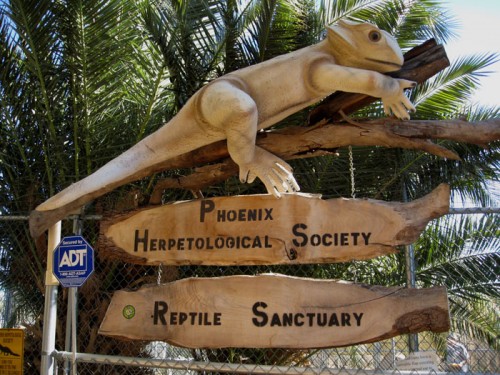Phoenix Herpetological Society
 Vicki arranged for a tour of the Phoenix Herpetological Society (PHS) for some ASU colleagues. It seemed like a fascinating way to celebrate our anniversary (#24!), so E and I went. Vicki and her husband Calvin are long-time volunteers at PHS and they showed us around the facilities, which are up north off of Dynamite Rd in Scottsdale.
Vicki arranged for a tour of the Phoenix Herpetological Society (PHS) for some ASU colleagues. It seemed like a fascinating way to celebrate our anniversary (#24!), so E and I went. Vicki and her husband Calvin are long-time volunteers at PHS and they showed us around the facilities, which are up north off of Dynamite Rd in Scottsdale.
 We swam a python, scrubbed an education ‘gator, and fed other alligators and a crocodile, tortoises, and iguanas of several species. By “we” I mean Vicki and Calvin, while the rest of us took pictures and asked questions. We helped a little, lobbing handfuls of produce at large lizards, poking expiration-date challenged chicken legs and donated elk shreds by the gobbet through chain link enclosures with tongs, to be snapped up by eager gator jaws. Iguanas adore grapes, and African tortoises love lettuce. A lot of lettuce. Each day crates and crates of produce donated by grocery stores go into the non-native tortoise corrals. Any idea you may have had of slow-moving giants lying about motionless is destroyed once you see a horde of tortoises trundling towards lettuce mounds.
We swam a python, scrubbed an education ‘gator, and fed other alligators and a crocodile, tortoises, and iguanas of several species. By “we” I mean Vicki and Calvin, while the rest of us took pictures and asked questions. We helped a little, lobbing handfuls of produce at large lizards, poking expiration-date challenged chicken legs and donated elk shreds by the gobbet through chain link enclosures with tongs, to be snapped up by eager gator jaws. Iguanas adore grapes, and African tortoises love lettuce. A lot of lettuce. Each day crates and crates of produce donated by grocery stores go into the non-native tortoise corrals. Any idea you may have had of slow-moving giants lying about motionless is destroyed once you see a horde of tortoises trundling towards lettuce mounds.
 We watched Tigger, an 11 foot Reticulated Pythoness swim in the pool, while wallabies cowered at a distance. Tigger was beautiful, and unlike most snakes I’ve seen swimming who skim the surface skillfully but with purpose (why does a cottonmouth swim a creek? – to get to the other side), she was swimming for pleasure, and loved to dive down to the very bottom, where small bubbles trickled up from her iridescent scales. She looked at home in the water, like a very long, sinuous salamander. Another “Retic”, Donny, returned from an event just before we left. He was still coiled calmly in his open traveling crate, a very sturdy, well-ventilated plastic trunk on wheels, waiting for several volunteers to lift him back into his regular habitat. Donny weighs something like 350 pounds, is 18 feet long, and hasn’t maxed out in length yet.
We watched Tigger, an 11 foot Reticulated Pythoness swim in the pool, while wallabies cowered at a distance. Tigger was beautiful, and unlike most snakes I’ve seen swimming who skim the surface skillfully but with purpose (why does a cottonmouth swim a creek? – to get to the other side), she was swimming for pleasure, and loved to dive down to the very bottom, where small bubbles trickled up from her iridescent scales. She looked at home in the water, like a very long, sinuous salamander. Another “Retic”, Donny, returned from an event just before we left. He was still coiled calmly in his open traveling crate, a very sturdy, well-ventilated plastic trunk on wheels, waiting for several volunteers to lift him back into his regular habitat. Donny weighs something like 350 pounds, is 18 feet long, and hasn’t maxed out in length yet.
PHS is a place where unwanted/abandoned reptiles can find a home, where relocated rattlers live temporarily, and where herps used for education programs in schools and other venues both private and public are housed between gigs. Most of the animals we saw were either confiscated or abandoned — people leave critters in boxes on PHS’s doorstep, to avoid paying the drop-off fee. They’re homeless because of their owner’s inability or unwillingness to care for them as they grow larger.
 More animals are coming in to places like PHS these days because of the current economy and rising foreclosures and evictions; it’s the same at dog and cat shelters, too. We shed a few tax-deductible dollars their way before we left: PHS survives mostly on green — money or the edible sort. If you ever see your local grocer throwing away produce (or meat), tell them about Phoenix Herp Society — daily donations don’t always match the tortoises’ (and gators’) needs. And seeing all those sheltered animals drove home the need to think before buying an exotic herp to bring home: many of the PHS’s tortoises, and even some of the snakes and monitors are available for adoption to suitable homes, a really hands-on way to help out (you need to apply, be approved and pay an adoption fee). Or consider volunteering, or hiring PHS to bring critters to a home birthday party or work event for a truly unique and educational experience. Check out their website for more options.
More animals are coming in to places like PHS these days because of the current economy and rising foreclosures and evictions; it’s the same at dog and cat shelters, too. We shed a few tax-deductible dollars their way before we left: PHS survives mostly on green — money or the edible sort. If you ever see your local grocer throwing away produce (or meat), tell them about Phoenix Herp Society — daily donations don’t always match the tortoises’ (and gators’) needs. And seeing all those sheltered animals drove home the need to think before buying an exotic herp to bring home: many of the PHS’s tortoises, and even some of the snakes and monitors are available for adoption to suitable homes, a really hands-on way to help out (you need to apply, be approved and pay an adoption fee). Or consider volunteering, or hiring PHS to bring critters to a home birthday party or work event for a truly unique and educational experience. Check out their website for more options.
